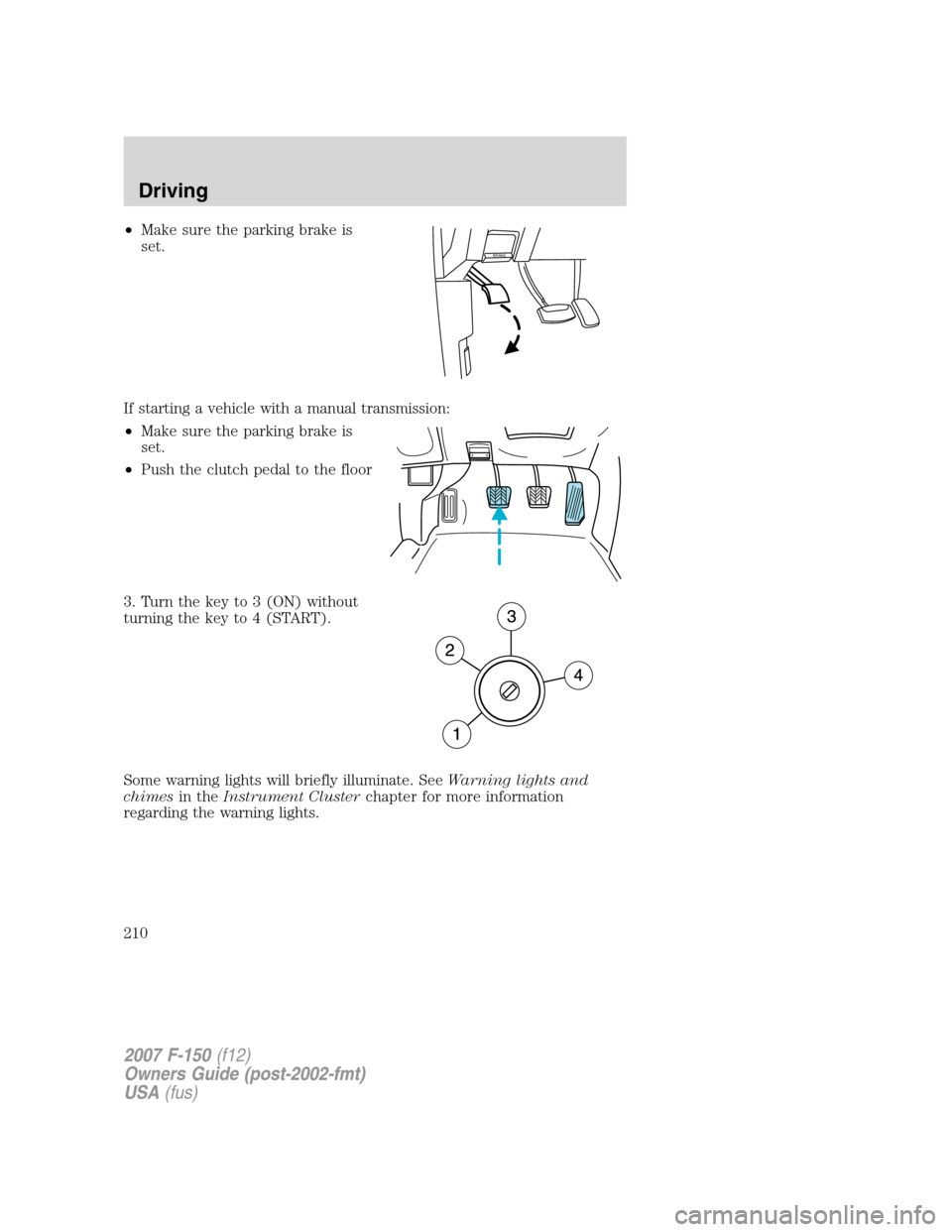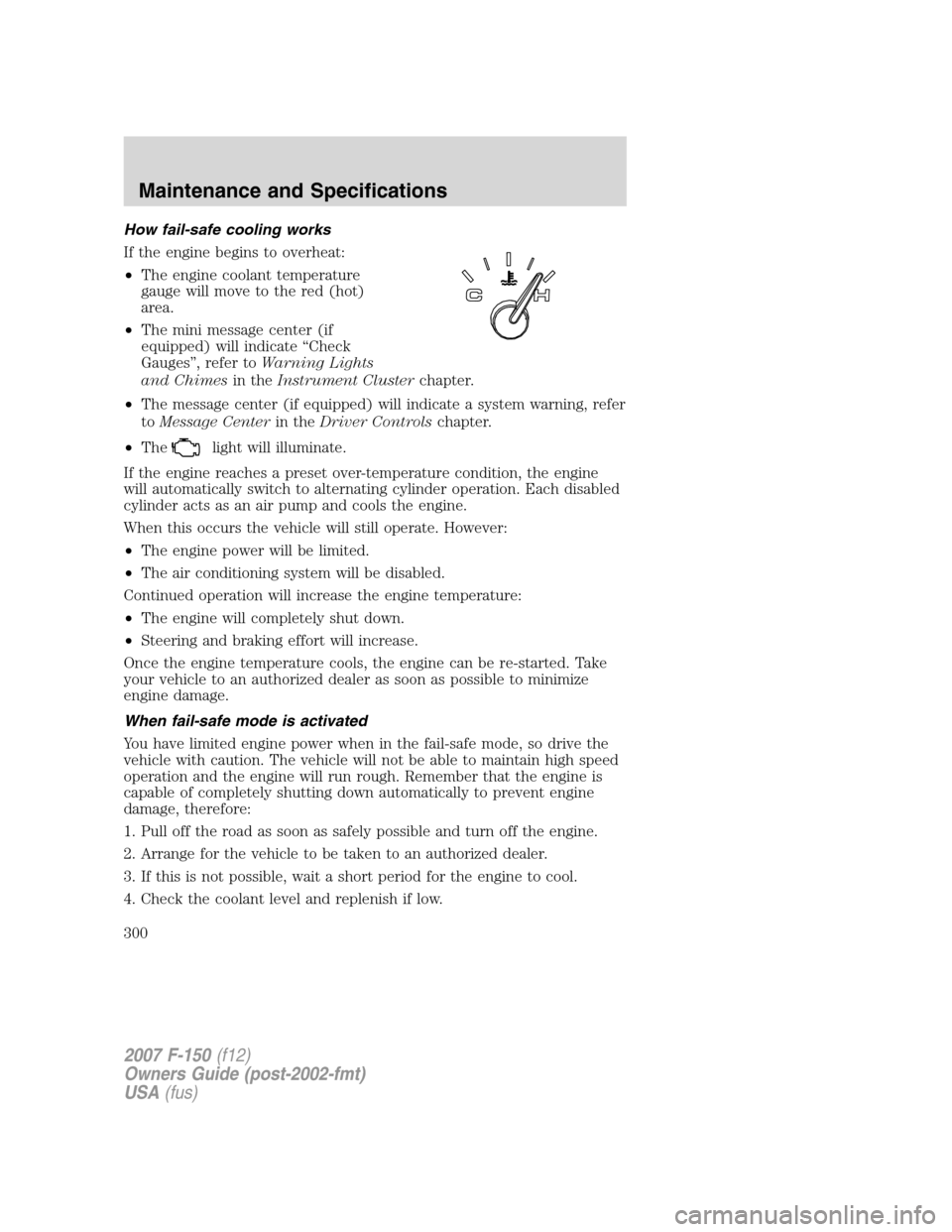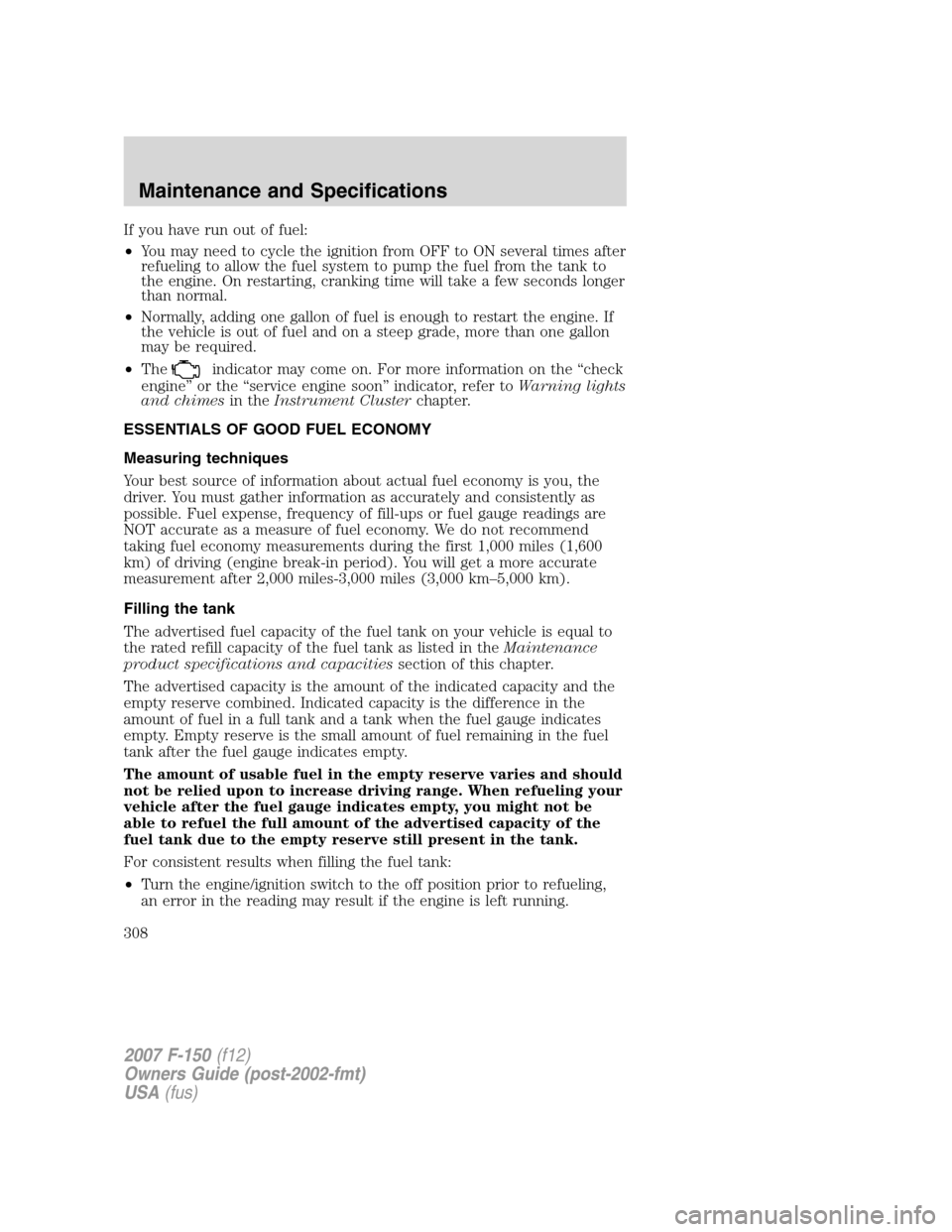2007 FORD F150 warning lights
[x] Cancel search: warning lightsPage 208 of 344

STARTING
Positions of the ignition
1. OFF/LOCK, locks the steering
wheel, automatic transmission
gearshift lever and allows key
removal.
Note:The ignition key cannot be
removed from the ignition unless
the gearshift lever is securely
latched in P (Park).
2. ACCESSORY, allows the electrical
accessories such as the radio to
operate while the engine is not running.
3. ON, all electrical circuits operational. Warning lights illuminated. Key
position when driving.
4. START, cranks the engine. Release the key as soon as the engine
starts.
Preparing to start your vehicle
Engine starting is controlled by the powertrain control system. This
system meets all Canadian Interference-Causing Equipment standard
requirements regulating the impulse electrical field strength of radio
noise.
When starting a fuel-injected engine, don’t press the accelerator before
or during starting. Only use the accelerator when you have difficulty
starting the engine. For more information on starting the vehicle, refer to
Starting the enginein this chapter.
Extended idling at high engine speeds can produce very high
temperatures in the engine and exhaust system, creating the risk
of fire or other damage.
Do not park, idle, or drive your vehicle in dry grass or other dry
ground cover. The emission system heats up the engine
compartment and exhaust system, which can start a fire.
2007 F-150(f12)
Owners Guide (post-2002-fmt)
USA(fus)
Driving
208
Page 210 of 344

•Make sure the parking brake is
set.
If starting a vehicle with a manual transmission:
•Make sure the parking brake is
set.
•Push the clutch pedal to the floor
3. Turn the key to 3 (ON) without
turning the key to 4 (START).
Some warning lights will briefly illuminate. SeeWarning lights and
chimesin theInstrument Clusterchapter for more information
regarding the warning lights.
BRAKE
2007 F-150(f12)
Owners Guide (post-2002-fmt)
USA(fus)
Driving
210
Page 300 of 344

How fail-safe cooling works
If the engine begins to overheat:
•The engine coolant temperature
gauge will move to the red (hot)
area.
•The mini message center (if
equipped) will indicate “Check
Gauges”, refer toWarning Lights
and Chimesin theInstrument Clusterchapter.
•The message center (if equipped) will indicate a system warning, refer
toMessage Centerin theDriver Controlschapter.
•The
light will illuminate.
If the engine reaches a preset over-temperature condition, the engine
will automatically switch to alternating cylinder operation. Each disabled
cylinder acts as an air pump and cools the engine.
When this occurs the vehicle will still operate. However:
•The engine power will be limited.
•The air conditioning system will be disabled.
Continued operation will increase the engine temperature:
•The engine will completely shut down.
•Steering and braking effort will increase.
Once the engine temperature cools, the engine can be re-started. Take
your vehicle to an authorized dealer as soon as possible to minimize
engine damage.
When fail-safe mode is activated
You have limited engine power when in the fail-safe mode, so drive the
vehicle with caution. The vehicle will not be able to maintain high speed
operation and the engine will run rough. Remember that the engine is
capable of completely shutting down automatically to prevent engine
damage, therefore:
1. Pull off the road as soon as safely possible and turn off the engine.
2. Arrange for the vehicle to be taken to an authorized dealer.
3. If this is not possible, wait a short period for the engine to cool.
4. Check the coolant level and replenish if low.
2007 F-150(f12)
Owners Guide (post-2002-fmt)
USA(fus)
Maintenance and Specifications
300
Page 308 of 344

If you have run out of fuel:
•You may need to cycle the ignition from OFF to ON several times after
refueling to allow the fuel system to pump the fuel from the tank to
the engine. On restarting, cranking time will take a few seconds longer
than normal.
•Normally, adding one gallon of fuel is enough to restart the engine. If
the vehicle is out of fuel and on a steep grade, more than one gallon
may be required.
•The
indicator may come on. For more information on the “check
engine” or the “service engine soon” indicator, refer toWarning lights
and chimesin theInstrument Clusterchapter.
ESSENTIALS OF GOOD FUEL ECONOMY
Measuring techniques
Your best source of information about actual fuel economy is you, the
driver. You must gather information as accurately and consistently as
possible. Fuel expense, frequency of fill-ups or fuel gauge readings are
NOT accurate as a measure of fuel economy. We do not recommend
taking fuel economy measurements during the first 1,000 miles (1,600
km) of driving (engine break-in period). You will get a more accurate
measurement after 2,000 miles-3,000 miles (3,000 km–5,000 km).
Filling the tank
The advertised fuel capacity of the fuel tank on your vehicle is equal to
the rated refill capacity of the fuel tank as listed in theMaintenance
product specifications and capacitiessection of this chapter.
The advertised capacity is the amount of the indicated capacity and the
empty reserve combined. Indicated capacity is the difference in the
amount of fuel in a full tank and a tank when the fuel gauge indicates
empty. Empty reserve is the small amount of fuel remaining in the fuel
tank after the fuel gauge indicates empty.
The amount of usable fuel in the empty reserve varies and should
not be relied upon to increase driving range. When refueling your
vehicle after the fuel gauge indicates empty, you might not be
able to refuel the full amount of the advertised capacity of the
fuel tank due to the empty reserve still present in the tank.
For consistent results when filling the fuel tank:
•Turn the engine/ignition switch to the off position prior to refueling,
an error in the reading may result if the engine is left running.
2007 F-150(f12)
Owners Guide (post-2002-fmt)
USA(fus)
Maintenance and Specifications
308
Page 337 of 344

Illuminated visor mirror .............69
Infant seats
(see Safety seats) .....................153
Inspection/maintenance (I/M)
testing ........................................313
Instrument panel
cleaning ...................................277
cluster ........................................12
lighting up panel and
interior .......................................60
J
Jack ............................................252
positioning ...............................252
storage .....................................252
Jump-starting your vehicle ......259
K
Keyless entry system ...............110
autolock ...................................101
keypad .....................................110
locking and unlocking doors ..111
programming entry code .......111
Keys ...................................101, 113
positions of the ignition .........208
L
Lamps
autolamp system .......................58
bulb replacement
specifications chart ..................63
daytime running light ...............59
fog lamps ...................................59
headlamps .................................58
headlamps, flash to pass ..........59
instrument panel, dimming .....60
interior lamps .....................62–63
replacing bulbs ...................64, 67Lane change indicator
(see Turn signal) ........................61
Lights, warning and indicator ....12
anti-lock brakes (ABS) ..........213
Load limits .................................188
Loading instructions .................194
Locks
autolock ...................................101
childproof ................................103
doors ........................................101
Lubricant specifications ...........324
Lug nuts ....................................259
Lumbar support, seats .............117
M
Manual transmission .................223
reverse .....................................225
Message center ...........................89
english/metric button ...............93
system check button ................93
warning messages .....................94
Mirrors .........................................77
automatic dimming rearview
mirror ........................................76
fold away ...................................77
heated ........................................78
programmable memory ..........106
side view mirrors (power) .......77
signal .........................................78
Moon roof ....................................82
Motorcraft parts ........281, 301, 322
N
Navigation system .......................47
O
Octane rating ............................306
2007 F-150(f12)
Owners Guide (post-2002-fmt)
USA(fus)
Index
337
Page 339 of 344

Spark plugs,
specifications .....................322, 328
Special notice
ambulance conversions ..............8
four-wheel drive vehicles .......240
utility-type vehicles ....................8
Specification chart,
lubricants ...................................324
Speed control ..............................79
Starting a flex fuel vehicle .......211
Starting your
vehicle ........................208–209, 211
jump starting ..........................259
Steering wheel
controls ......................................81
tilting .........................................68
T
Tailgate ........................................98
Temperature control
(see Climate control) .................48
Tilt steering wheel ......................68
Tire Pressure Monitoring
System (TPMS)
Tires, Wheels and Loading ....184
Tires ...........................169–170, 252
alignment ................................177
care ..........................................173
changing ..........................252, 255
checking the pressure ............173
inflating ...................................171
label .........................................183
replacing ..................................175
rotating ....................................177
safety practices .......................176
sidewall information ...............178
snow tires and chains ............188
spare tire .................................252terminology .............................171
tire grades ...............................170
treadwear ........................170, 174
Towing .......................................194
recreational towing .................206
trailer towing ..........................194
Traction control ........................215
Traction-lok rear axle ...............216
Transfer case
fluid checking .........................319
Transmission .............................217
brake-shift interlock
(BSI) ................................217–218
fluid, checking and adding
(automatic) .............................316
fluid, checking and adding
(manual) .................................318
fluid, refill capacities ..............324
lubricant specifications ..........324
manual operation ....................223
Turn signal ..................................61
V
Vehicle Identification Number
(VIN) ..........................................330
Vehicle loading ..........................188
Ventilating your vehicle ...........212
W
Warning lights (see Lights) .......12
Washer fluid ..............................288
Water, Driving through .............238
Windows
power .........................................74
power down back window .......75
2007 F-150(f12)
Owners Guide (post-2002-fmt)
USA(fus)
Index
339